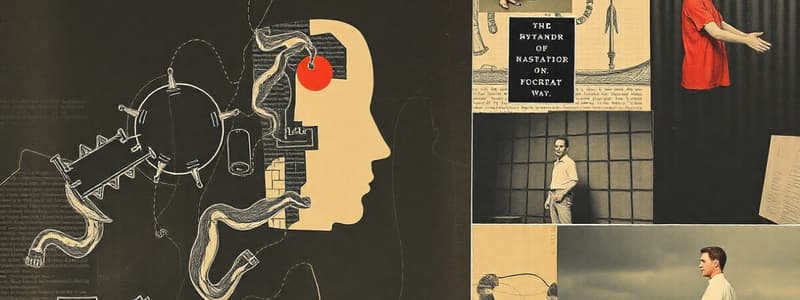Podcast
Questions and Answers
What event sparked the investigation into the behavior of bystanders in emergency situations?
What event sparked the investigation into the behavior of bystanders in emergency situations?
- A study on group psychology
- The development of the scientific method
- The murder of Kitty Genovese (correct)
- An experiment involving confederates
What hypothesis was formed regarding bystander intervention?
What hypothesis was formed regarding bystander intervention?
- Bystanders are more likely to intervene when alone.
- More bystanders increase the likelihood of help.
- Diffusion of responsibility decreases helping behavior. (correct)
- The presence of confederates has no effect on helping behavior.
What was the main method used to test the hypothesis in the research?
What was the main method used to test the hypothesis in the research?
- Creating a simulated emergency in a controlled environment (correct)
- Surveying bystanders after real emergencies
- Observing naturalistic behaviors in public spaces
- Conducting interviews with witnesses
What effect was observed in the study regarding helping behavior?
What effect was observed in the study regarding helping behavior?
During the experiment, what role did the 'confederate' play?
During the experiment, what role did the 'confederate' play?
In the scientific method, what is the purpose of analyzing data?
In the scientific method, what is the purpose of analyzing data?
What is meant by 'diffusion of responsibility' in the context of the bystander effect?
What is meant by 'diffusion of responsibility' in the context of the bystander effect?
What is the first step in the scientific method as outlined in the research process?
What is the first step in the scientific method as outlined in the research process?
What is the operational definition of a variable?
What is the operational definition of a variable?
Which of the following is NOT a method of measuring variables?
Which of the following is NOT a method of measuring variables?
What limitation is associated with self-report methods?
What limitation is associated with self-report methods?
Which type of variable measurement involves recording actual behavior?
Which type of variable measurement involves recording actual behavior?
What is a common limitation of physiological measurement methods?
What is a common limitation of physiological measurement methods?
Which of the following statements is true regarding the methods of measurement?
Which of the following statements is true regarding the methods of measurement?
What information can be gathered through self-report methods?
What information can be gathered through self-report methods?
What is required to ensure the reliability of behavioral measurements?
What is required to ensure the reliability of behavioral measurements?
What method can be used to reduce effects like boredom and fatigue in testing?
What method can be used to reduce effects like boredom and fatigue in testing?
What is the main concern with confounded variables in experiments?
What is the main concern with confounded variables in experiments?
What type of improvement is referred to as the placebo effect?
What type of improvement is referred to as the placebo effect?
In a study where one group listens to Mozart and another relaxes, what ability was reportedly tested?
In a study where one group listens to Mozart and another relaxes, what ability was reportedly tested?
What does reliability in research indicate?
What does reliability in research indicate?
What is a primary concern regarding validity in experimental procedures?
What is a primary concern regarding validity in experimental procedures?
Which of the following is NOT a factor that can threaten research validity?
Which of the following is NOT a factor that can threaten research validity?
What is a potential solution to overcome the placebo effect?
What is a potential solution to overcome the placebo effect?
What is a significant limitation of case studies?
What is a significant limitation of case studies?
Which of the following describes a benefit of naturalistic observation?
Which of the following describes a benefit of naturalistic observation?
What is required for a sample to be considered representative?
What is required for a sample to be considered representative?
What does a positive correlation indicate between two variables?
What does a positive correlation indicate between two variables?
What is a major downside of surveys?
What is a major downside of surveys?
What is the range of values for a correlational coefficient, r?
What is the range of values for a correlational coefficient, r?
What is a key feature of correlational studies?
What is a key feature of correlational studies?
What is the primary goal of correlational research?
What is the primary goal of correlational research?
In research, what is meant by 'unobtrusive measures'?
In research, what is meant by 'unobtrusive measures'?
What was a notable issue with the Hite Report conducted in 1987?
What was a notable issue with the Hite Report conducted in 1987?
Which statement about the strength of correlation is correct?
Which statement about the strength of correlation is correct?
What does a negative correlation signify?
What does a negative correlation signify?
Which of the following scenarios demonstrates a positive correlation?
Which of the following scenarios demonstrates a positive correlation?
What is a key limitation of correlational research?
What is a key limitation of correlational research?
What is indicated by a correlational coefficient of 0.00?
What is indicated by a correlational coefficient of 0.00?
Which research method is likely most effective for understanding the 'why' behind behaviors?
Which research method is likely most effective for understanding the 'why' behind behaviors?
Study Notes
Kitty Genovese Incident
- In March 1964, Kitty Genovese was stabbed and raped in New York City on her way home.
- The attack lasted 30 minutes and involved repeated stabbings.
- 38 neighbours heard the screams and pleas for help, but no one intervened.
- The incident sparked debate about the psychology of bystander apathy and the diffusion of responsibility.
The Scientific Method
- A systematic approach to understanding phenomena.
- Strives to minimize biases, personal beliefs, and emotions.
- Aims to identify questions of interest, gather information, form hypotheses, test hypotheses, analyze data, and build a body of knowledge.
Initial Observation and Question
- The Kitty Genovese incident sparked a question: Why did no one help?
Form Hypothesis
- A specific, testable prediction.
- Example: If multiple bystanders are present, then a diffusion of responsibility will decrease each bystander's likelihood of intervening.
Testing the Hypothesis
- Researchers created a simulated emergency in a laboratory setting.
- Undergraduates in separate rooms talked to each other via intercom.
- A confederate (researcher posing as a participant) faked a seizure, asking for help.
- The number of other participants the subject believed to be present was manipulated.
- The number of subjects who helped was measured.
Analyze Data
- Helping decreased as the perceived number of bystanders increased, supporting the hypothesis of diffusion of responsibility.
Further Research
- Additional studies supported the hypothesis in various situations.
- The findings led to the development of the theory of social impact.
Defining & Measuring Variables
- Variable: Any characteristic that can vary (e.g., stress, weight, reaction time).
- Operational definition: Defines a variable in terms of specific procedures used to produce or measure it.
Methods of Measurement
- Self-report: Individuals report their knowledge, beliefs, feelings, and experiences.
- Can be gathered through interviews, questionnaires, and psychological tests.
- Limitations: Social desirability bias and interviewer bias.
- Physiological: Measures biological responses.
- Examples: Blood pressure, hormonal secretions, brain activity.
- Limitations: Physiological responses do not always explain mental events.
- Behavioral: Records observable actions.
- Requires coding systems for consistent measurement.
- Limitations: Observer bias and reactivity (changing behavior due to being observed).
- Unobtrusive measures help mitigate some limitations.
Methods of Research
- Descriptive Research: Describes behavior in natural settings.
- Examples: Case studies, naturalistic observation, and surveys.
- Correlational Studies: Examine relationships between variables.
- Do not establish cause-and-effect relationships.
- Experimental Methods: Investigate cause-and-effect relationships.
- Involve manipulating an independent variable to observe its effect on a dependent variable.
Case Studies
- In-depth analysis of an individual's behaviors and experiences.
- Advantages: Useful for studying rare phenomena and providing a starting point for further research.
- Disadvantages: Limited generalizability and potential for researcher bias.
Naturalistic Observation
- Observing behavior in a natural setting.
- Advantages: Provides rich description of behavior in a real-world context.
- Disadvantages: Time-consuming, potential for researcher influence on behavior, and primarily descriptive (cannot explain "why").
Surveys
- Gather data from individuals through questionnaires.
- Widely used in many fields of psychology.
- Useful for describing attributes of a population.
- Population: Entire group of interest.
- Sample: Subset of the population selected to complete the survey.
Representative Sample
- Essential for drawing conclusions that apply to the entire population.
- Random sampling techniques (e.g., selecting every 10th person) help ensure a representative sample.
Hite Report (1987)
- Surveyed 100,000 women about their relationships.
- Found that most women were unhappy.
- The sample was not representative because only 1% of the survey recipients responded, leading to potential bias.
Correlational Research
- Studies relationships between variables.
- Goal is to determine if an association exists between variables.
- Does not establish causality.
- Variables are not manipulated, only measured.
Correlational Coefficient (r)
- A statistical measure of the strength and direction of the relationship between two variables.
- Ranges from -1.0 to +1.0.
Direction of Correlation
- Positive (+) indicates that both variables vary in the same direction (one increases, the other increases).
- Negative (-) indicates that variables vary in opposite directions (one increases, the other decreases).
Strength of Correlation
- The absolute value of the coefficient (ignoring the sign) indicates the strength of the relationship.
- Higher absolute values indicate stronger relationships.
- A correlation of 0.00 means no relationship.
Confounded Variables
- Unintended differences between conditions that can potentially influence the dependent variable.
- Can make it difficult to interpret experimental results.
- Critical to ensure that the independent variable, not a confounded variable, is responsible for any observed effects.
Placebo Effect
- Improved outcomes resulting from the expectation of improvement, even if the treatment is not effective.
- To control for the placebo effect, researchers often use control groups that receive a placebo (fake treatment) to compare their outcomes to the experimental group.
Validity and Reliability
- Validity: How accurately an experimental procedure tests what it is intended to test.
- Is the study measuring what it claims to measure?
- Reliability: How consistent the results are with other similar studies.
- Do the results replicate across multiple trials or studies?
Studying That Suits You
Use AI to generate personalized quizzes and flashcards to suit your learning preferences.
Related Documents
Description
Explore the psychological concepts surrounding the Kitty Genovese incident, a pivotal case that raises questions about bystander apathy and responsibility. This quiz delves into the scientific method and critical thinking in understanding human behavior in emergency situations.




